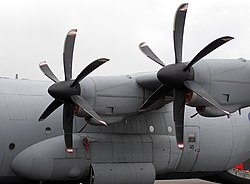
Back Skroef (lugvaart) Afrikaans مروحة (علم الطيران) Arabic Паветраны вінт Byelorussian Въздушен винт Bulgarian Vrtule Czech Propelfly Danish Luftschraube German Propeller Estonian ملخ (هوانوردی) Persian Hélice (aéronautique) French
This article needs additional citations for verification. (September 2011) |

In aeronautics, an aircraft propeller, also called an airscrew,[1][2] converts rotary motion from an engine or other power source into a swirling slipstream which pushes the propeller forwards or backwards. It comprises a rotating power-driven hub, to which are attached several radial airfoil-section blades such that the whole assembly rotates about a longitudinal axis. The blade pitch may be fixed, manually variable to a few set positions, or of the automatically variable "constant-speed" type.
The propeller attaches to the power source's driveshaft either directly or through reduction gearing. Propellers can be made from wood, metal or composite materials.
Propellers are most suitable for use at subsonic airspeeds generally below about 480 mph (770 km/h), although supersonic speeds were achieved in the McDonnell XF-88B experimental propeller-equipped aircraft. Supersonic tip-speeds are used in some aircraft like the Tupolev Tu-95, which can reach 575 mph (925 km/h).[citation needed]
- ^ Beaumont, R.A.; Aeronautical Engineering, Odhams, 1942, Chapter 13, "Airscrews".
- ^ Wragg, David W. (1973). A Dictionary of Aviation (first ed.). Osprey. p. 28. ISBN 9780850451634.